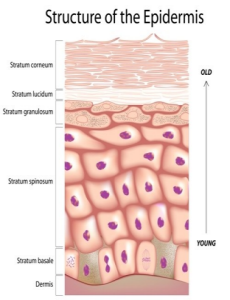Recognizing the Signs of Aging
January 23, 2015

![]() How we look can often tell someone a great deal about us. For example what our ethnic background might be, or that of our parents, whether we love being in the sun or the outdoors, what our age might be, or whether we smoke or not. Many factors influence how we look, but not all of these factors affect us all equally and to the same extent. It is this very question of why some factors age some people quicker or slower that is intriguing the Nu Skin scientists as we study how skin ages.
How we look can often tell someone a great deal about us. For example what our ethnic background might be, or that of our parents, whether we love being in the sun or the outdoors, what our age might be, or whether we smoke or not. Many factors influence how we look, but not all of these factors affect us all equally and to the same extent. It is this very question of why some factors age some people quicker or slower that is intriguing the Nu Skin scientists as we study how skin ages.
The signs of aging manifest themselves differently on skin. Research by Nu Skin and others is just beginning to answer these questions and is showing that this is a complex process involving many players, such as our genes and epigenetics, lifestyle choices, and exposure to environmental factors like sun and pollution, etc.
We are probably all too familiar with many of the signs of aging. Visible signs of skin aging can appear as early as the twenties and many of the events that lead up to these visible changes can start deep in the skin, sometimes even in childhood. For example, the amount of sun exposure and especially sun burns, we receive as children can have a long-lasting effect on the support structure of the skin, which in adulthood manifests itself as fine lines, wrinkles and sagging.

The Effect of the Sun
Solar elastosis particularly refers to sun damage on one of the critical components of our skin – elastin. Elastin is vital in keeping our skin firm and supple, allowing it to snap back into place after skin is stretched. Even though this component is in the deeper dermal layers of the skin, UV rays from the sun can penetrate deep into the dermis and are very damaging to elastin. Over time, UV damage can cause a completely irregular structure of elastin to become apparent in the dermis, such that it can no longer provide its much needed elasticity.
What Difference does Skin Color Make?
Different ethnic skin types often differ in how aging appears on the skin surface. For those with darker skin, changes in skin pigmentation are more frequently implicated in the aging process. Here, signs of aging include changes in skin tone, age spots and irregularity of the pigment appearance over the skin surface.
Skin color is largely controlled by the presence and quantity of two things: 1) a pigment molecule called melanin and 2) hemoglobin, which is the red component of our blood cells.
The amount and type of melanin in our skin is the predominant factor in giving the skin color, as well as determining our hair color. Melanin is produced by specialized skin cells which reside in the basal layer of the epidermis of skin. Melanin production by melanocytes is increased in response to sun exposure, thus providing a tanned appearance. With age, these melanocytes change and create irregular pigmentation patterns associated with age that are visible on the skin’s surface. Appearance and severity of these features have been documented in detail by Bazin et al. in the Skin Aging Atlas (v. 1-3)1 for Caucasian, Asian, and African-American skin.
One study used imaging techniques to analyze the individual contributions of melanin and hemoglobin to different skin colors in Asian and Caucasian skin and examine changes with increasing age2. Age-related changes in the melanin component of both Asian and Caucasian skin were noted, but the heterogeneity of hemoglobin was much more pronounced in Caucasian compared to Asian skin. This means that the color provided by the blood circulation to the skin has a greater effect on Caucasian individuals and may explain why these individuals often have age related redness on their cheeks and why broken blood vessels become more apparent with age.
The Relationship between Age and Skin Moisture

Skin moisture is also noted to change as we get older, and this differs between different ethnic skin types. One study showed that skin dryness is more pronounced on sun exposed lighter skin (Caucasian & Chinese) than on sun protected sites3, while no differences in dryness were observed in sun exposed vs. sun protected darker skin types. Further, skin dryness did not change in the 18 to 50 age group, but was more pronounced in both Africa-American and Caucasian skin at age 51+, with a greater percentage increase in Caucasian skin. Additionally, studies have shown that because of skin scaling and dryness, our outer skin cells can be more easily removed as we age and come away in greater numbers.
Signs of aging are diverse, varying from appearance of fine lines, wrinkles and sagging to changes in skin color, as well as changes in skin moisture and texture. What we are uncovering as skin scientists is a better understanding of how these factors come about and how we can influence how we age, so that we can appear at our best at all times.
References
1. Bazin, R. et al. Skin Aging Atlas, Paris. Editions Med’Com, v1 (2007) v2 (2010) v3 (2012).
2. de Rigal, J. et al. (2010) The effect of age on skin color and color heterogeneity in four ethnic groups. Skin Res Tech 16: 168-178.
3. Diridollou, S. et al. (2007) Comparative study of the hydration of the stratum corneum between four ethnic groups: influence of age. Int J Dermatol Soc 46(Suppl 1): 11-14.

Written by
Helen Knaggs
Nu Skin VP Global Research and Development
You Might Also Like:
-
Exfoliation can smooth and soften the skin by removing dead skin cells in the stratum corneum, the outermost layer of the epidermis. Also known as desquamation, the removal of this “horny layer” can improve the skin’s appearance. Rough skin texture—resulting from aging, sun exposure, compromised moisture barrier, etc.—reflects light unevenly, making skin appear dull and sallow. Accelerating cell t...
-
At-home beauty devices are becoming increasingly prevalent, promising to reduce wrinkles, improve facial cleansing, and brighten skin. These handheld instruments are based on technologies and treatments conducted in spas, esthetician offices, and/or medical suites. Some of the most popular technologies include LEDs, cleansing brushes, microcurrents, and ultrasound.

